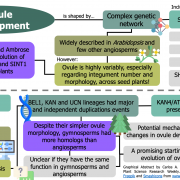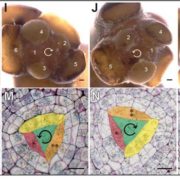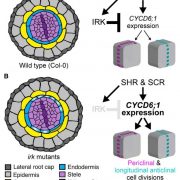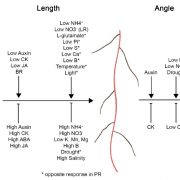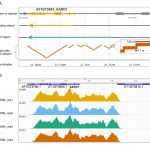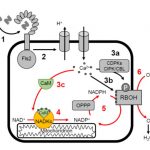NODULE INCEPTION recruits the lateral root developmental program for symbiotic nodule organogenesis in Medicago truncatula ($) (Curr Biol)
 Lateral roots are secondary root organs arising through the dedifferentiation of inner cell layers in the primary root. Nodules arise through symbiosis with rhizobia bacteria in a certain clade of land plants and they also arise through dedifferentiation. Both lateral roots and nodules are part of the plant root system architecture and aid in nutrient uptake from the rhizosphere. There are some similarities and differences in the morphology and developmental molecular signals between the two organs. In this paper Schiessl et al. have identified the cytokinin-auxin signaling events that contribute to primordia development in roots and also the similarity in cytokinin-induced auxin biosynthesis during the organ development. Auxin accumulation occurs at pre-marked sites in the primary root for lateral root development, and nodule development occurs through flavonoid-mediated auxin transport inhibition. LBD16 (LOB-DOMAIN PROTEIN 16) promotes the expression of auxin biosynthesis genes upon induction by cytokinin treatment during nodule development, and LBD16 overexpression leads to increased lateral root production, suggesting that LBD16 could act as a point of convergence for development of both organs. Also, there is a 75% overlap in gene expression between the two lateral organs indicating that nodule development is likely to share some molecular pathways with lateral roots. (Summary by Suresh Damodaran) Curr. Biol. 10.1016/j.cub.2019.09.005
Lateral roots are secondary root organs arising through the dedifferentiation of inner cell layers in the primary root. Nodules arise through symbiosis with rhizobia bacteria in a certain clade of land plants and they also arise through dedifferentiation. Both lateral roots and nodules are part of the plant root system architecture and aid in nutrient uptake from the rhizosphere. There are some similarities and differences in the morphology and developmental molecular signals between the two organs. In this paper Schiessl et al. have identified the cytokinin-auxin signaling events that contribute to primordia development in roots and also the similarity in cytokinin-induced auxin biosynthesis during the organ development. Auxin accumulation occurs at pre-marked sites in the primary root for lateral root development, and nodule development occurs through flavonoid-mediated auxin transport inhibition. LBD16 (LOB-DOMAIN PROTEIN 16) promotes the expression of auxin biosynthesis genes upon induction by cytokinin treatment during nodule development, and LBD16 overexpression leads to increased lateral root production, suggesting that LBD16 could act as a point of convergence for development of both organs. Also, there is a 75% overlap in gene expression between the two lateral organs indicating that nodule development is likely to share some molecular pathways with lateral roots. (Summary by Suresh Damodaran) Curr. Biol. 10.1016/j.cub.2019.09.005


